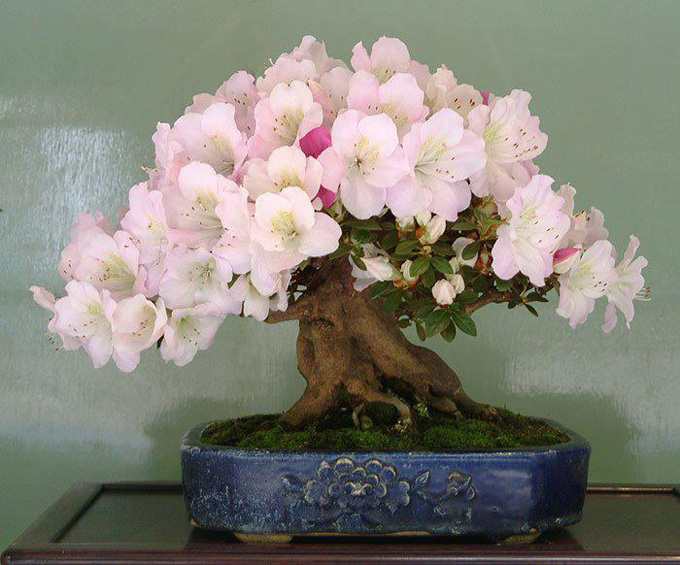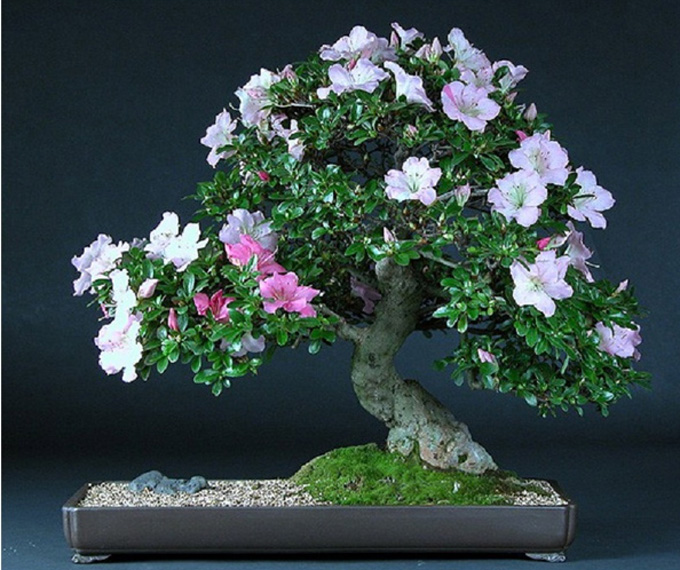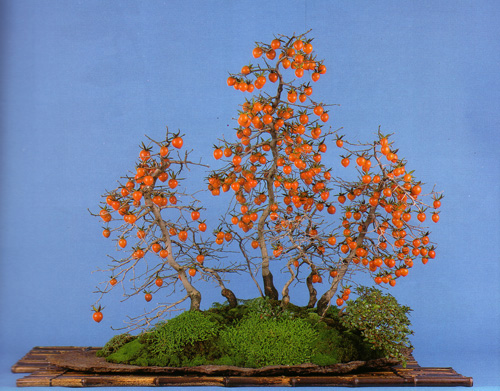 This azalea would be an excellent bonsai even without the flowers. With the flowers, I’d say it’s a stunningly beautiful bonsai. I found it on Tae Kukiwon Bonsai. One thing I like about this sweet little tree, is how, even though the flowers are stunningly striking, the trunk holds its own. A trunk with less power and character wouldn’t stand a chance. Like so many photos on facebook, it’s unattributed.
This azalea would be an excellent bonsai even without the flowers. With the flowers, I’d say it’s a stunningly beautiful bonsai. I found it on Tae Kukiwon Bonsai. One thing I like about this sweet little tree, is how, even though the flowers are stunningly striking, the trunk holds its own. A trunk with less power and character wouldn’t stand a chance. Like so many photos on facebook, it’s unattributed.
Can there ever be too many flowers?
If you look at the two azaleas in this post, you’ll see that the one above is covered with flowers, while the one below shows a mix of flowers and foliage. Some bonsai and landscape artists think that flowers work best when used judiciously; as an accent or highlight, rather than as the whole story. Others (most of us) seem to feel that the more flowers, the better.
East versus West?
Perhaps the difference is cultural. In Japan, you’ll often see flowers used as highlights (bright spots). In the West, you’ll often see flowers used in a completely dominant way; flowers for flowers sake. Before you get too excited, I know that these kinds of too-easy-generalizations are fraught with danger; that there are examples in Japanese horticultural arts of flowers for flowers sake, still, if you look at the Japanese art of ikebana versus the Western art of flower arranging, for example (or bonsai and landscape gardening, in some cases at least), you’ll find ample evidence of cultural differences in the way flowers are used.
 Though the tree isn’t in the same league as the one above, it provides an example of the less-is-more approach, where the flowers don’t overwhelm the viewer. This allows other features to stand out. Things like the shiny glow of the foliage, the trunk, the overall shape of the tree, and the way it is planted (a somewhat unusual saikei style in this case). I found this photo here (also unattributed).
Though the tree isn’t in the same league as the one above, it provides an example of the less-is-more approach, where the flowers don’t overwhelm the viewer. This allows other features to stand out. Things like the shiny glow of the foliage, the trunk, the overall shape of the tree, and the way it is planted (a somewhat unusual saikei style in this case). I found this photo here (also unattributed).
 This quince shows a profusion of flowers, but still, there’s space for the trunks, the pot and other features to be appreciated. It’s from the same place as the photo immediately above (and it’s also unattributed).
This quince shows a profusion of flowers, but still, there’s space for the trunks, the pot and other features to be appreciated. It’s from the same place as the photo immediately above (and it’s also unattributed).
 Color is not just about flowers. This Princess persimmon (Diospyros kaki) is from Bonsai Today issue 39 and is a rerun from an earlier Bonsai Bark post. Among other things, it’s a good example of balanced color contrast, especially with the choice of background color.
Color is not just about flowers. This Princess persimmon (Diospyros kaki) is from Bonsai Today issue 39 and is a rerun from an earlier Bonsai Bark post. Among other things, it’s a good example of balanced color contrast, especially with the choice of background color.
I think the red-flowered bush is a Chaenomeles (quince), probably Domoto’s Red Bricks.
I feel that, when blooming, azaleas are about the flowers, when not blooming, they should be good bonsai. Plant #2 looks like it is in an off year. The variety (Gyoten?) is not, however, all that floriferous.
Hi Terry,
Thanks for the info and your insights.
Hi Wayne,
In examining the differing number of flowers between the two satsuki above, this may also be attributed to the timing of the photos during the flowering season. The satsuki on top may have had the good fortune of snapping a picture at its peak while the lower may have been earlier in the season. I suggest this as it appears there are several buds on the lower tree prepared to open fully. The same plant may attain its peak at slightly different time each year based upon seasonal, and health, considerations.
Satsuki intended for display in a “formal” flowering show do observe rules around presentation. That is, there should be enough room for the flowers to open fully without overlapping adjacent flowers. This is accomplished with strategic removal of buds in the time leading up to the show. To my knowledge, there is no consideration (favorable or negative) given whether the flower presentation is “austere” or “abundant”. As in any display, the plant is assessed on how closely it exhibits the characteristics of its variety and style.
Great question and blog!
Thanks Rick,
Excellent points. I just learned something!